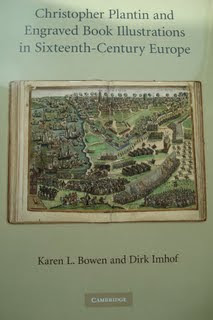
Short-Title Catalogue
Netherlands or
STCN (www.kb.nl/stcn), is the online retrospective bibliography of books published between 1540-1800 in The Netherlands, and of Dutch books printed abroad. The project will be celebrating its completion on
25 June 2009.
Occasion for these wishes is the festive closure of the STCN-project at Leiden, today, 4 June, 2009, with an exhibition, Vreemdigheden en rariteyten; zeldzame boeken uit de Leidse collecties, set to illustrate the diversity of book production at Leiden. The contribution of Leiden imprints at University of Leiden to STCN is vast: 70.000 titles and 90.000 copies. But Leiden gained prominence around 1575, when the oldest still existing university of The Netherlands was founded.
In all, 170,000 (190,000) titles and 420,000 (500,000) copies have passed review. A total of 22 Dutch libraries and 2 libraries overseas, in London - holdings at BL and University of Londen, more precisely the Elzevier collection – have been receiving collaborators of the bureau of the STCN, who examined holdings.
Let’s recap. STCN kicked off in 1982. Phase 1 took 5 years, until 1987, and knew the input of 6 collaborators. Result was the description of all printed books before 1701 at the Royal Library in The Hague (KB Den Haag).
1988 marked the beginning of a phase 2, which was finalized in March 1997. All books in libraries in Amsterdam and Leiden were scrutinized. More collaborators got involved. In 1995, the last 100 years 1701-1800 were included, and the bureau got a foothold at KB Den Haag.
Phase 3, devoted to the period 1701-1800, saw completion in 2000, but was extended by 2 years. In 2002, at the end of phase 3, the database counted 123,000 entries.
For celebrations, and for another reason we’re glad to look extra muros.
In 1800, no “The Netherlands”, no “Belgium” existed. Willem I reunited what had been “Belgicum”, “Flandres”, “Paesi Bassi”, “Het Nederland” or “De Nederlanden”, as seen from Burgundy’s seat in France in the 15th century and from Madrid the next.
Despite the Treaty of Münster in 1648, which ended a battle for political and religion differentiation, and which led to the 17 provinces of “Olanda” in the North, and the Spanish-Austrian provinces in the South, a mental separation took longer to take effect.
France later reunited les départments Belgiques, and so did Willem I. According to Hugo De Schepper, a North-South fissure did happen in Willem’s assemblée, due to the seating system.
So STCN has a sibling for Dutch editions printed in Belgium: STCV, Short Title Catalogus Vlaanderen.
STCV is younger: born in 2000, with a cradle at University of Antwerp and use of the university’s software. There's the input of 2 collaborators, and a description of editions in Dutch printed in Flanders in 1601-1700, at first not opting to ruffle the feathers of Belgica Typographica (BT). The approach slightly deviates from that of STCN.
Phase 1 lasted until 2003, and resulted in 6226 seen copies and 4850 entries. Phase 2 included other languages, and editions printed before 1601. Flemish government support –culture and education are regionalized in Belgium- was garnered along the way.
Today, Diederik Lanoye, STCV’s collaborator, is working at the Erfgoedbibliotheek Hendrik Conscience in Antwerp to cover lacunae for the 17th century.
In the course of this year, STCV will be incorporated in the association of 6 Flemish heritage libraries or Erfgoedbibliotheken Vlaanderen. The bureau hopes to examine 2,400 copies per annum. Presently, the counter reached 10,000 entries.
 On a day when a Belgian prime minister is receiving accolade for becoming the first President ever of the European Counsel, we are pleased to announce that the book Christopher Plantin and Engraved Book Illustrations in Sixtieenth-Century Europe, by Karen L. Bowen and Dirk Imhof (Cambridge UP, ISBN 978052185276-0), has received the Roland H. Bainton Book Prize.
On a day when a Belgian prime minister is receiving accolade for becoming the first President ever of the European Counsel, we are pleased to announce that the book Christopher Plantin and Engraved Book Illustrations in Sixtieenth-Century Europe, by Karen L. Bowen and Dirk Imhof (Cambridge UP, ISBN 978052185276-0), has received the Roland H. Bainton Book Prize.













